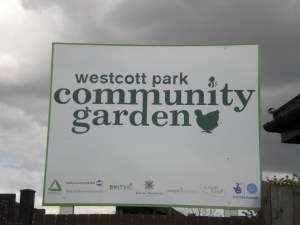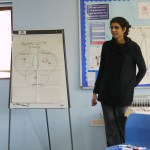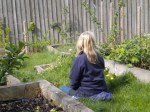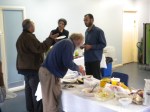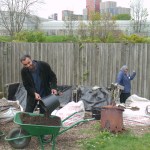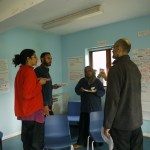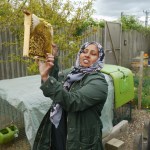Blog Archives
Report (+ Photos!) from 2-day Permaculture Course with Social Design in Ealing, London.
We recently received a delightful invitation to deliver a two-day Permaculture workshop at Westcott Park Community Garden, in Acton, Ealing (West London).
We were really excited about this, as it meant three things:
- Working with particiapants from a range of economic and cultural backgrounds.
- Within the course we had been asked to facilitate participants through a social design for the Westcott Park Community Garden Group (and we love facilitating and working with groups for real life challenges!).
- We get to see the community garden and meet some of the team (Nuria, who we had actually already met, as well as Mani and Asha).
The two-day course took place at the end of April/beginning of May (2015).
Day 1 involved an Intro to Permaculture workshop, touching on the ethics of permaculture and key principles through a variety of exercises, as well as an outdoor observation (or what we sometimes like to call ‘nature witnessing’) exercise, and a site tour.
Participants also went through a simulated land-based permaculture design to support them in integrating what they had learnt.
Day 2 involved practical gardening (led by the community garden team), and participants also kicked off a social permaculture design. This design was to serve a real-life need: to help support the Westcott Park Community Gardening Group develop a resilient volunteer system for their garden.
There was alot of work needed in the garden, with just a handful of volunteers. A fresh strategy was being asked for to address this imbalance.
Much of this session involved enquiry, which under the Permaculture ‘S-A-D-I-M‘ design-process acronym would come under ‘S’ or Survey… asking questions of the garden team to get a sense of how things have been and are right now.
It is really important (if we want to work with nature rather than against it) that we spend time consciously ‘observing’ the social or physical landscape, before launching into any significant change or intervention. This is especially important when we are new to a site, or to a group – and can also help a group see its own strengths, limitations and patterns more clearly.
Thus, only after we had all spent time taking in the current situation and specific needs (and then eating some good food and spending time in the garden!) did we – facilitators and participants – move into brainstorming possible strategies or solutions.
We did not plan (due to time constraints) to group the solutions together, narrow them down, or begin to consciously consider them in terms of permaculture ethics and principles, for example. The aim, in the time we had, was to get the ball rolling, and for the gardening group (having also been introduced to permaculture thinking) to take these ideas, and consider them in their own time, space and way, with us available for questions if needed.
Below are a few more photos. Please also visit the Westcott Park Community Garden Facebook Page.
And, if you (or anyone you know in the Acton area of London) would like to volunteer at the garden, please get in touch with the group.
Two-Day Permaculture Course (West London: April/May 2015)
 Principles to Regenerate the Earth and Strengthen our Communities
Principles to Regenerate the Earth and Strengthen our Communities
Course dates: Sat 25 April (10am-6pm) & Sat 2 May (10am-4pm)
Venue: Westcott Park Community Centre & Garden, 13 Ferguson Drive, Acton, London. W3 6YP.
Advance Booking ONLY; See below.
Permaculture is a practical system for sustainable living, based on observing principles and patterns in nature. By maximising relationships in living systems, permaculture has empowered people worldwide to develop dynamic, resilient projects that work with nature, rather than against it. Whatever scale or aspect of human living, whether the home and garden, community or congregation space, or one’s own life and career, permaculture can be applied to each situation.
Day 1: Introduction to permaculture; Visit to the community garden.
Day 2: Permaculture applied-design: A volunteers plan; Practical gardening.
The course content will include:
- What is permaculture?
- Introduction to permaculture ethics and principles
- Nature observation
- Social permaculture
- Permaculture as a design system
- Applying permaculture
- Next steps
Course fees
£60 if you live outside a one mile radius of the garden.
(Free if you live within the one mile radius)
This course is partially funded by Catalyst Gateway and supported by Routes of Wholeness.
Workshop Facilitators
Shumaisa Khan (Permaculture Designer & Sustainability Tutor)
Muzammal Hussain (Permaculture Designer & Group Facilitator)
Bookings
Booking in advance is essential. For more info and bookings:
Tel: 07424 876 797
OR
Email: westcottparkcommunitygarden@outlook.com
Note: Bookings for this course are being taken by Westcott Park Community Garden, not by Routes of Wholeness.
Food
Bring lunch to share. Refreshments are provided
Why No Digging?: Nature as a Teacher
“Why no digging?“… This important question was recently asked following a post I wrote titled, ‘9 Months No-Dig Permaculture in Smal l Growing Space‘.
l Growing Space‘.
I felt the answer to this question deserved a blog post of its own, and which can then be referred to in future posts around no-dig approaches to food growing.
How nature replenishes itself
How I understanding permaculture is that it draws on nature as a teacher. Nature can be an example of how to nourish and regenerate the earth.
Nature demonstrates deep and coherent principles of sustainability, and if through witnessing and reflecting on nature, we can be humble enough to allow nature to be our teacher, there are principles we might discover that nature embodies and that we can apply in creating our own systems, whether this be around food growing, economic systems, or social ones. Of course these can all interact, and that is one of the beauties of this interconnected dynamic world we are part of!
So, back to digging. If we look at nature, we can see that it rarely digs in the sense that it rarely dramatically inverts the soil. Instead, nature tends to work gently. In a forest, for instance, leaves fall, they slowly breakdown on the surface, and are gradually taken to deeper layers, in particular through earthworm activity. This process of organic matter being left on the soil surface and taken down (without digging) is a part of the process that naturally builds the fertility of the soil and feeds life, a foundation for the creative effortless development and sustenance of a forest and the abundance that comes from it for an incredibly diverse range of life forms.
Drawing on Nature’s principles
Permaculture would be not about copying this exactly, but about drawing on these principles to design systems (permaculture is a design approach) that provide for our needs in a sustainable way – which means also caring for our wider family: the earth and our fellow human beings.
Choosing to minimise digging
Breaking it down a bit more, here are some specific tangible reasons for not digging (or at least minimising it):
- By inverting the soil, many microorganisms accustomed to living and functioning at a particular soil depth will die, and this impacts negatively on soil fertility (and increases the need for adding fertilisers/external inputs).
- Digging can bring weed seeds to the surface, increasing the need for further digging and leading to an upward spiral of digging! Instead what we have been doing on our plot is, in part, seeing weeds as a form of life that store valuable nutrients. By just hoeing weeds along the surface of the soil, we leave them on the surface (as mulch) where they suppress further weed growth and break down naturally, gradually releasing nourishment for other life, like leaves do when falling on the soil surface in a forest.
- Soil is a carbon sink. Digging releases the carbon stored in the ground into the atmosphere, so is counter to what we ideally want to be doing to reduce greenhouse gas emissions.
A bit of an experiment!
When we began our plot with a no-dig approach, it was a bit of an experiment! We were not sure how things would turn out. Although it’s been only nine months and it’s raised eyebrows, we’ve certainly found that weed growth on our plot seems to be much less now than on many others in the area, meaning less work in the long run, and the soil looks much richer as well.
‘It depends!’
While digging is something I would try to avoid where possible, there is an unofficial permaculture principle that underlies all of them, and prevents permaculture from becoming dogmatic. This principle is ‘It depends‘! After all, there are instances where some kind of digging would be appropriate and helpful (e.g. in heavily compacted soil). The aim, instead of no digging [full stop], is rather to create the conditions that minimise the need to dig, particularly over the longer term, and that means digging as little as possible in the first place. In our case, we have been fortunate whereby we have got away essentially without digging the soil at all.
All the best to everyone who is working (or working less!) to do this, and thank you to all my teachers who have helped me to explore the wonderful approach of permaculture which continues to support me in drawing on principles in nature to inspire my work in all its forms.
—
I have found these two books to be really helpful (and both of which have pages about tilling/not tilling the soil):
The Permaculture Garden: by Graham Bell (simpler)
The Earth Care Manual: By Patrick Whitefield (more comprehensive)
Muzammal Hussain
This work is licensed under a Creative Commons Attribution-ShareAlike 3.0 Unported License
9 Months No-Dig Permaculture in Small Growing Space
It’s been just over 9 months since we got our very own plot on an allotment site in Reigate, and we’ve used that time to apply permaculture to food growing.
On this post, I’d like to share a couple of photos to help convey some kind of pictorial overview as to changes that took place on our permaculture plot during that time.
Below is the plot as we got it about 9 months ago, in December 2012. The photo is taken from the south-east corner of the plot>>
You can see lots of grass and weeds. The plot had not been worked on for many months as the previous plot-holder was suffering from poor health.
After taking stock of the plot and reflecting on how to move forward, we thought that realistically it made sense that we work primarily on about half of it for the first year, and also use that time to gain more familiarity with the site.
We were committed to using permaculture principles, no insecticides/herbicides (i.e. organic) and to working with the plot without digging.
So, How did we do?! Let’s move to the ‘nine months later’ mark. Just below is a photo taken from about the same position in September 2013…
Early on, we built a compost structure from reclaimed wooden pallets (top part of photo). The area we’ve been growing on is about 16 square meters. We divided it into four beds, two are horse shoe shaped and two are rectangular.
Crops that we’ve been growing on these four beds include:
potatoes,
perpetual spinach,
swiss beet,
french beans (Blauhilde and Golden Gate varieties),
courgettes,
kale,
radish,
carrots,
and squash…
and yes, we did manage to work on the weedy site to grow all this food without digging! (A couple of open workdays helped, so thank you to everyone who came down for them).
Hopefully I’ll get a chance to share more about how we did this on a future post.
Muzammal Hussain
This work is licensed under a Creative Commons Attribution-ShareAlike 3.0 Unported License.
